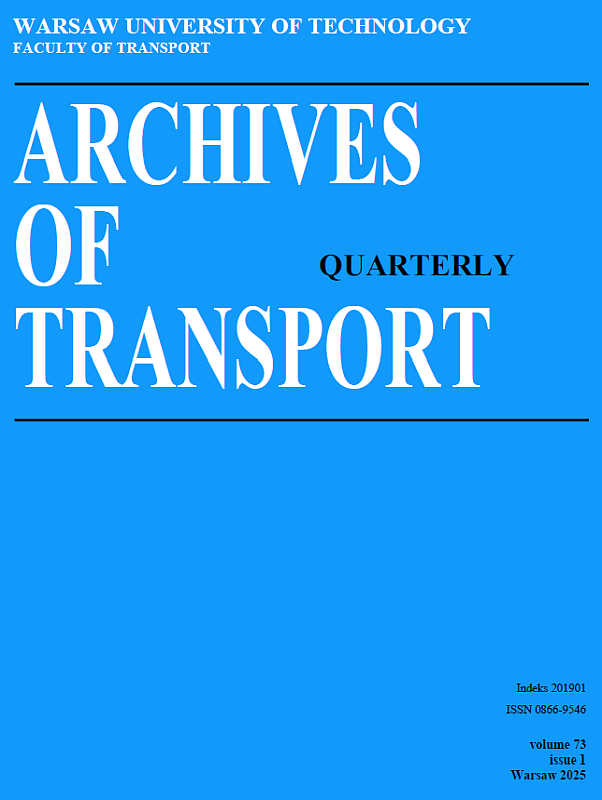Methodology for evaluating the dynamic parameters of the rubber-cord shell of a high-speed rolling stock pneumatic spring in the wheel-frog interaction of a railroad switch
DOI:
https://doi.org/10.61089/aot2025.v5vdb115Keywords:
pneumatic spring, rubber-cord shell, switch frog, acceleration, frequency, logarithmic decrementAbstract
The object of research is a pneumatic spring of the spring suspension system for high-speed railway rolling stock. A methodology for full-scale dynamic testing of a pneumatic spring of high-speed rolling stock when interacting with a rail track has been developed. The vertical, transverse, and longitudinal accelerations of the rubber-cord shell of the pneumatic spring of the high-speed rolling stock during trailing and facing directions movement along the turnout crossing crossing are determined. It is established that the average values of vertical accelerations in the trailing direction and facing direction movements are higher than the average values of transverse and longitudinal accelerations. It is noted that the values of the average values of vertical and longitudinal accelerations in the trailing direction movement are 24.6% and 13.9% higher than the average values of the accelerations in the facing direction movement. Equality of the values of the average values of transverse accelerations in trailing direction and facing direction movements is noted. Graphs of the amplitude spectrum and logarithmic damping of vibrations of the rubber-cord shell of a pneumatic spring of high-speed rolling stock are obtained. It is established that the average value of the first natural frequency of oscillations of the rubber-cord shell of the pneumatic spring in the vertical, transverse and longitudinal directions during the trailing direction movement along the railroad turnout crossing is 3.17 Hz, 3.7 Hz and 3.49 Hz, and the logarithmic decrement of the oscillation damping is 0.46 , 0.30 and 0.29, respectively. For the facing direction movement, the natural frequency is 3.45 Hz, 3.56 Hz, and 3.47 Hz, and the logarithmic decrement of oscillation damping is 0.35, 0.41, and 0.31, respectively. From a practical point of view, the obtained first frequencies of natural oscillations for the rubber-cord shell of the new pneumatic spring of the high-speed rolling stock are basic, which will allow further monitoring of the change in the dynamic characteristics of the pneumatic spring depending on the operational mileage of the rolling stock.
References
1. Bayraktar, M., Guclu, R., & Metin, M. (2009). Modelling of air springs in a rail vehicle. 13th International Research/Expert Conference ”Trends in the Development of Machinery and Associated Technology”, 829–832.
2. Berg, M. (1999). A Three–Dimensional Airspring Model with Friction and Orifice Damping. Vehicle System Dynamics, 33(sup1), 528–539. https://doi.org/10.1080/00423114.1999.12063109
3. Chang, W., Cai, X., Wang, Q., Tang, X., Sun, J., & Yang, F. (2022). The Influence of Track Irregularity in Front of the Turnout crossing on the Dynamic Performance of Vehicles. Applied Sciences, 12(9), 4169. https://doi.org/10.3390/app12094169
4. Chen, J., Yin, Z., Yuan, X., Qiu, G., Guo, K., & Wang, X. (2021). A refined stiffness model of rolling lobe air spring with structural parameters and the stiffness characteristics of rubber bellows. Measurement, 169. https://doi.org/10.1016/j.measurement.2020.108355.
5. Chen, R., Ping, W., & Wei, X.K. (2011). Influence of Conversion Deviation on Dynamic Performance of High-Speed Railway Turnout crossing. Key Engineering Materials, 474-476, 1599-1604, https://doi.org/10.4028/www.scientific.net/KEM.474-476.1599
6. Chen, Y., Wang, J., Chen, J., Wang, P., Xu, J., & An, B. (2021). A novel three-dimensional wheel–rail contact geometry method in the switch panel considering variable cross-sections and yaw angle. Vehicle System Dynamics, 60(9), 3174–3197. https://doi.org/10.1080/00423114.2021.1941140
7. Diana, G., Cheli, F., Collina, A., Corradi, R., & Melzi, S. (2002). The Development of a Numerical Model for Railway Vehicles Comfort Assessment Through Comparison With Experimental Measurements. Vehicle System Dynamics, 38(3), 165–183. https://doi.org/10.1076/vesd.38.3.165.8287
8. Docquier, N., Fisette, P., & Jeanmart, H. (2007). Multiphysic modelling of railway vehicles equipped with pneumatic suspensions. Vehicle System Dynamics, 45(6), 505–524. https://doi.org/10.1080/00423110601050848
9. Facchinetti, A., Mazzola, L., Alfi, S., & Bruni, S. (2010). Mathematical modelling of the secondary airspring suspension in railway vehicles and its effect on safety and ride comfort. Vehicle System Dynamics, 48(sup1), 429–449. https://doi.org/10.1080/00423114.2010.486036
10. Gao, Y., Xu, J., Liu, Y., Dong, Z., Wang, P., & Jiang, Z. (2020). An investigation into transient frictional rolling contact behaviour in a switch panel: validation and numerical simulation. Vehicle System Dynamics, 60(1), 114–131. https://doi.org/10.1080/00423114.2020.1802492
11. Hao, C., Xu, J., Qian, Y., An, B., Wang, P., Yi, Q., & Wang, S. (2023). Impact of wheel profile evolution on the lateral motion characteristics of a high-speed vehicle navigating through turnout crossing. Vehicle System Dynamics, 62(8), 2079–2097. https://doi.org/10.1080/00423114.2023.2274468
12. Kamada, T., & Karaki, T. (2023). Active vertical vibration suppression of high-speed railway vehicles by controlling internal pressure of the air spring using μ-synthesis control. Vehicle System Dynamics, 62(7), 1621–1636. https://doi.org/10.1080/00423114.2023.2250024
13. Kandasamy, S., Nicolsen, B., Shabana, A., & Falcone, G. (2021). Evaluation of effectiveness of pneumatic suspensions: Application to liquid sloshing problems. Journal of Sound and Vibration, 514. https://doi.org/10.1016/j.jsv.2021.116328
14. Kuzyshyn, A., Kovalchuk, V., Sobolevska, Y., Royko, Y., & Kravets, I. (2024a). Determining the effect of additional tank volume and air pressure in the spring on the dynamic indicators of a pneumatic system of spring suspension in high-speed railroad rolling stock. Eastern-European Journal of Enterprise Technologies, 3/7 (129), 47–62. https://doi.org/10.15587/1729-4061.2024.304051
15. Kuzyshyn, A., Sobolevska, J., Kostritsa, S., Batig, A. & Boiarko, V. (2023). Mathematical modeling of the second stage of spring suspension of high-speed rolling stock. AIP Conference Proceedings, 2684(1), 1–7. https://doi.org/10.1063/5.0120402
16. Li, H., Guo, K., Chen, S., Wang, W., & Cong, F. (2013). Design of stiffness for air spring based on ABAQUS. Mathematical Problems in Engineering, 2013, 1–5. https://doi.org/10.1155/2013/528218
17. Ma, X., Wang, P., Xu, J., Chen, R. (2019). Comparison of non-Hertzian modeling approaches for wheel–rail rolling contact mechanics in the switch panel of a railway turnout crossing. Proceedings of the Institution of Mechanical Engineers, Part F: Journal of Rail and Rapid Transit, 233(4), 466–476. https://doi.org/10.1177/0954409718799825
18. Mellado, A. C., Casanueva, C., Vinolas, J., & Giménez, J. G. (2008). A lateral active suspension for conventional railway bogies. Vehicle System Dynamics, 47(1), 1–14.
19. https://doi.org/10.1080/00423110701877512
20. Mendia-Garcia, I., Facchinetti, A., Bruni, S., & Gil-Negrete, N. (2023). Analysis and modelling of the dynamic stiffness up to 400 Hz of an air spring with a pipeline connected to a reservoir. Journal of Sound and Vibration, 557, 1–18. https://doi.org/10.1016/j.jsv.2023.117740
21. Mendia-Garcia, I., Gil-Negrete, N., Nieto, F. J., Facchinetti, A., & Bruni, S. (2022). Analysis of the axial and transversal stiffness of an air spring suspension of a railway vehicle: mathematical modelling and experiments. International Journal of Rail Transportation, 12(1), 56–75. https://doi.org/10.1080/23248378.2022.2136276
22. Moheyeldein, M. M., Abd-El-Tawwab, A. M., Abd El-gwwad, K. A., & Salem, M. M. (2018). An analytical study of the performance indices of air spring suspensions over the passive suspension. Beni-Suef University Journal of Basic and Applied Sciences, 7(4), 525–534. https://doi.org/10.1016/j.bjbas.2018.06.004
23. Nabochenko, O., Sysyn, M., Krumnow, N. Fischer, S (2024a). Mechanism of cross-level settlements and void accumulation of wide and conventional sleepers in railway ballast. Railw. Eng. Sci. https://doi.org/10.1007/s40534-024-00329-5
24. Nabochenko, O., Sysyn, M. & Fischer, S. (2024b)Ballast Settlement Accumulation in Zones with Unsupported Sleepers. Transp. Infrastruct. Geotech. https://doi.org/10.1007/s40515-024-00388-5
25. Qi, Z., Li, F., & Yu, D. (2017). A three-dimensional coupled dynamics model of the air spring of a high-speed electric multiple unit train. Proceedings of the Institution of Mechanical Engineers, Part F: Journal of Rail and Rapid Transit, 231(1), 3–18. https://doi.org/10.1177/0954409715620534
26. Redchenko, V. P., Kryuchkov, Yu. V., & Redchenko, T. V. (2011). Study of the problem of detecting bridge defects using vibration diagnostics. Bulletin of the Dnipropetrovsk National University of Railway Transport, 39, 168–172. (in Ukraine)
27. Shin, Y-J., You, W-H., Hur, H-M., Park, J-H., & Lee, G-S. (2014). Improvement of Ride Quality of Railway Vehicle by Semiactive Secondary Suspension System on Roller Rig Using Magnetorheological Damper. Advances in Mechanical Engineering, 6, 1–10. https://doi.org/10.1155/2014/298382
28. Szabolcs, Fischer (2023). Evaluation of inner shear resistance of layers from mineral granular materials.
29. Facta Universitatis Series Mechanical Engineering. https://doi.org/10.22190/FUME230914041F
30. Tanaka, T., & Sugiyama, H. (2019). Prediction of railway wheel load unbalance induced by air suspension leveling valves using quasi-steady curve negotiation analysis procedure. Proc. Inst. Mech. Eng. Part K: J. Multi-Body Dyn, 234, 19–37. https://doi.org/10.1177/1464419319867179
31. Toyokawa, S., Shiozaki, M., Yoshida, J., Watanabe, D., Sawa, T., & Haraguchi, H. (2020). Simulation Technology for Air Springs of Railway Systems. Sei technical review, 90, 13–16.
32. Wu, M.Y., Yin, H., Li, X.B., Lv, J.C., Liang, G.Q., & Wei, Y.T. (2022). A new dynamic stiffness model with hysteresis of air springs based on thermodynamics. Journal of Sound and Vibration, 521, 1–14. https://doi.org/10.1016/j.jsv.2021.116693
33. Xu, J., Wang, P., Ma, X., Gao, Y., & Chen, R. (2016). Stiffness Characteristics of High-Speed Railway Turnout crossing and the Effect on the Dynamic Train-Turnout crossing Interaction. Shock Vib, 2016, 1–14. https://doi.org/10.1155/2016/1258681
34. Yan, JM., & Fu, MH. (2012). Vehicle engineering (third ed.). People’s Republic of China: China Railway Publishing House, p. 274.
35. Yang, Y., Zeng, W., Qiu, W., & Wang, T. (2016). Optimization of the suspension parameters of a rail vehicle based on a virtual prototype Kriging surrogate model. Proceedings of the Institution of Mechanical Engineers, Part F: Journal of Rail and Rapid Transit, 230(8), 1890–1898. https://doi.org/10.1177/0954409715617213
36. Zheng, Y., & Shangguan, W. (2023). A combined analytical model for orifice-type and pipe-type air springs with auxiliary chambers in dynamic characteristic prediction. Mechanical Systems and Signal Processing, 185. https://doi.org/10.1016/j.ymssp.2022.109830
37. Zheng, Y., Shangguan, W., & Rakheja, S. (2022). Modeling and analysis of time-domain nonlinear characteristics of air spring with an auxiliary chamber. Mechanical Systems and Signal Processing, 176. https://doi.org/10.1016/j.ymssp.2022.109161
38. Zhou, R., Zhang, B. & Li, Z. (2022). Dynamic modeling and computer simulation analysis of the air spring suspension. Journal of Mechanical Science and Technology, 36, 1719–1727. https://doi.org/10.1007/s12206-022-0308-2
39. Zhu, H., Yang, J., & Zhang, Y. (2021). Dual-chamber pneumatically interconnected suspension: Modeling and theoretical analysis. Mechanical Systems and Signal Processing, 147. https://doi.org/10.1016/j.ymssp.2020.107125
40. Zhu, JY. (2006). On the effect of varying stiffness under the switch rail on the wheel–rail dynamic characteristics of a high-speed turnout crossing. Proceedings of the Institution of Mechanical Engineers, Part F: Journal of Rail and Rapid Transit, 220(1), 69–75. https://doi.org/10.1243/095440905X8943
41. Kuzyshyn, A., Kovalchuk, V., Royko, Y., Hermaniuk, Y., Tereshchak, Y., & Pulariia, A. (2024b). Determining the dynamic indicators of the pneumatic spring for high-speed rolling stock in the zone of a rail joint along a railroad track. Eastern-European Journal of Enterprise Technologies, 6/7 (132), 65–74. https://doi.org/10.15587/1729-4061.2024.315183
Downloads
Published
Issue
Section
License
Copyright (c) 2025 Archives of Transport journal allows the author(s) to hold the copyright without restrictions.

This work is licensed under a Creative Commons Attribution 4.0 International License.










